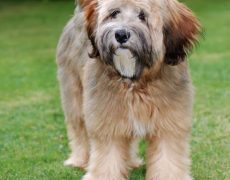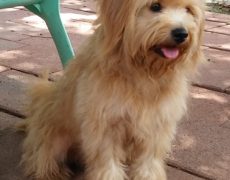Tibetan Terrier
Though named as the Tibetan Terrier, it does not belong to the terrier group. Medium in size, these powerful dogs have a moderately large head, big, dark, well-set eyes, V-shaped ears, muscular, compact body, and a high set, feathered tail, curled to its back. `Having a free and effortless gait, these dogs make for a charming and affectionate pet.
Tibetan Terrier Pictures
- Black Tibetan Terrier Puppies
- Black Tibetan Terrier
- Dokhi Apso
- Pics of Tibetan Terrier
- Pictures of Tibetan Perriers
- Tibetan Terrier Black and White
- Tibetan Terrier Brown
- Tibetan Terrier Dog
- Tibetan Terrier Full Grown
- Tibetan Terrier Images
- Tibetan Terrier Mix
- Tibetan Terrier Pictures
- Tibetan Terrier Puppies
- Tibetan Terrier Puppy
- Tibetan Terrier Short Hair
- Tibetan Terriers
- Tsang Apso
- Tibetan Terrier
Quick Information
| Other names | Dokhi Apso, Tsang Apso |
| Coat | Double coat: Topcoat – Long and fine; Undercoat – Wooly |
| Color | Black, gold, brindle, black and white, black, white and gold, gold and white, golden brindle, white, sable, white and black, white and gold, black and brindle, black and gold, black and brown, brindle and white, fawn, gray, fawn and white, red, red and white, red brindle, sable and white, silver, silver and black, silver and white |
| Breed type | Purebred |
| Group | Herding, Companion |
| Average lifespan/ life expectancy | 15 to 16 years |
| Size (How big do they get) | Medium |
| Height | 14 to 20 inches |
| Weight | 18 to 30 lbs (Male); 20 to 25 lbs (Female) |
| Litter size | 5 to 8 puppies |
| Behavioral Characteristics | Smart, affectionate, fun loving, gentle, loyal, alert |
| Good with children | Yes for those above 7 years |
| Climate Compatibility | Adapts equally to hot and cold weather |
| Do they bark | Moderate to low |
| Shedding (Does it shed) | Minimal |
| Hypoallergenic | Yes |
| Competitive Registration Qualification/ Information | FCI, ANKC, AKC, KC (UK), CKC, UKC, NZKC |
| Country | Tibet |
Video of a 2-Week Old Tibetan Terrier Puppy
History and Origin
The history of the Tibetan Terrier dates back to more than 2000 years or even earlier than that. Created in the rough terrains of Tibet, they were considered to be great companions, as well as effective herding and watchdogs.
This breed was also regarded as Tibet’s holy dog since they were mostly brought up by the lamas or Buddhist monks.
They were never traded or ill-treated as doing the same could bring in bad luck not just to the particular family indulging in doing so but also the entire village. Instead, they were given in gifts as a gesture of thankfulness to return a service or favor.
However, this breed got a new lease of life and an opportunity to be exposed outside its place of origin all because of Dr. Agnes R. H. Greig who had been gifted one of these dogs after she saved the life of a Tibetan’s wife. It was a golden white female named Bunti eventually bred with a male, Rajah that Agnes had also received as a gift.
After being brought to Europe in the year 1922, the birth of the first litter occurred in 1924 which were registered by the name Lhasa Terriers, later on, changed to Tibetan Terrier by the Kennel Club of India. The first of these dogs reached the United States in 1956, with the Tibetan Terrier Club of America formed in the year 1957.
It attained AKC’s recognition in 1958 and presently holds the 95th rank of the 155 breeds the American Kennel Club has acknowledged. In the UK also the Tibetan Terrier Association had been established to cater to the development of this breed.
The Tibetan Terrier is said to be instrumental in developing certain breeds like Lhasa Apso, Tibetan Spaniel, Shi Tzu and Polish Lowland Sheepdog.
Tibetan Terrier Mixes
- Kobetan – Tibetan Terrier – Cocker Spaniel
- Tibecot – Tibetan Terrier x Coton de Tulear
- Tibepillon Terrier – Tibetan Terrier x Papillion
- Ttoodle – Tibetan Terrier x Poodle
- Tibalier – Tibetan Spaniel x Cavalier King Charles Spaniel
- Tibetan Chin – Tibetan Spaniel x Japanese Chin
- Tibetan Pug – Tibetan Spaniel x Pug
- Tibetan Spaltese –Tibetan Spaniel x Maltese
- Tibetan Wolfhound – Tibetan Spaniel x Irish Wolfhound
- Tibetanpei Spaniel – Tibetan Spaniel x Chinese Shar-Pei
Temperament and Personality
Owning a Tibetan Terrier is indeed a pleasure as you get a fun loving dog with an affectionate and pleasing disposition. They need constant companionship without which these dogs could get destructive.
They possess a reserved and alert nature, when it comes to strangers, intimating their owners about any unusual sight or sound by letting out a sharp bark. These traits make them excel as an efficient watchdog, though not a guard dog because of their polite and gentle demeanor. Most of them choose to remain at a designated place in their homes, preferably a window, stair landing or balcony from where they could keep vigilance on what is going around.
Though they are friendly with kids, the Tibetan terrier is better suited for homes having school going children as they have a rambunctious nature and could knock down the little ones in pursuit of play. Their equation with other dogs and cats are fine particularly if brought up with them since their puppy days
Care
Exercise
They have a moderately high exercise requirement because of their increased energy levels, needing at least two fifteen minutes or one half-an-hour walk in a day. They could also be your hiking, jogging or cycling partner. While indoors, give them a lot of interactive games to keep them busy and mentally rejuvenated.
Grooming
Brush your Tibetan Terrier’s long, flowy coat on a daily basis to keep it free from mats and tangles using a pin brush as well as a metal greyhound comb. Make it a point to mist its coat well with water before combing to prevent any hair breakage. Take care in removing the hair growing in its ear canal as it could result in ear infections. You can either do it manually or use a tweezer or artery clamp. If you find it difficult in cleaning its hair ar home ask a veterinarian to help you with this during your next visit. Bathe it once in a month and also ensure to clean its eyes as well as ears, alongside trimming its nails to keep any infections at bay. Brushing its teeth one time in a week would help to minimize chances of plaque and tartar buildup.
Health Problems
Having a fairly long lifespan, this is a healthy breed, though some of the common issues it may face include eye problems like lens luxation, progressive retinal atrophy, and cataracts, as well as hip dysplasia, luxating patella, and a heart murmur. They are also known to suffer from neuronal ceroid lipofuscinosis, a genetic disease, affecting the nerves, often leading to night blindness.
Training
Training the Tibetan Terrier is easy because of its good temper and high level of intelligence, though a firm and consistent master is needed to manage them tactfully.
- Keeping their wariness towards strangers in mind, it is essential to train them on socialization since the time they are puppies. When exposed to various situations and different kinds of people, they would be able to figure out the difference between the good and the bad and only bark or behave differently when they sense something wrong.
- Crate training at an early age would be needed for these dogs so that they would learn to stay by themselves for a considerable period instead of being so closely knit with their family
Feeding
Feed your Tsang Apso a good quality dry dog food alongside a nutritious homemade diet. However, these dogs are known to be allergic to wheat, grain, and dairy products. Hence, you need to be careful while selecting a dog food for their diet or preparing something at home for them.























